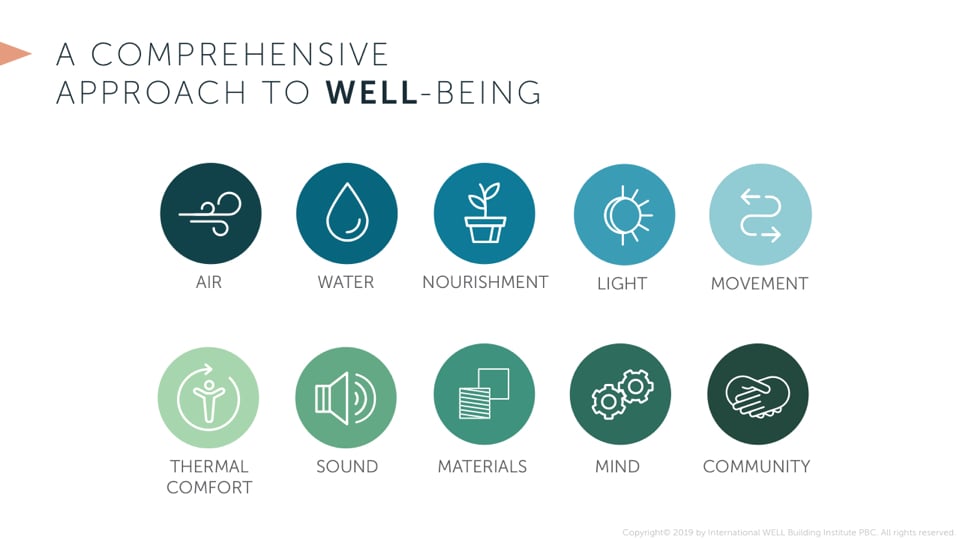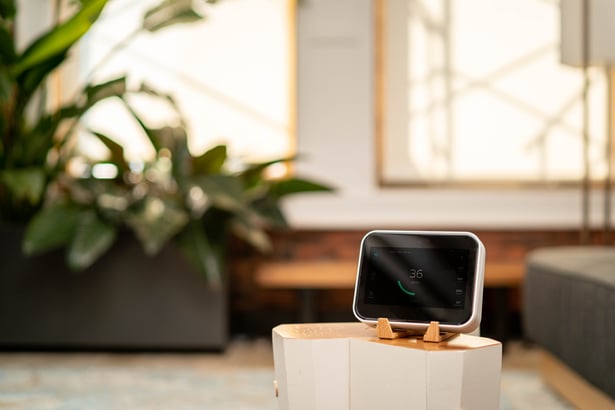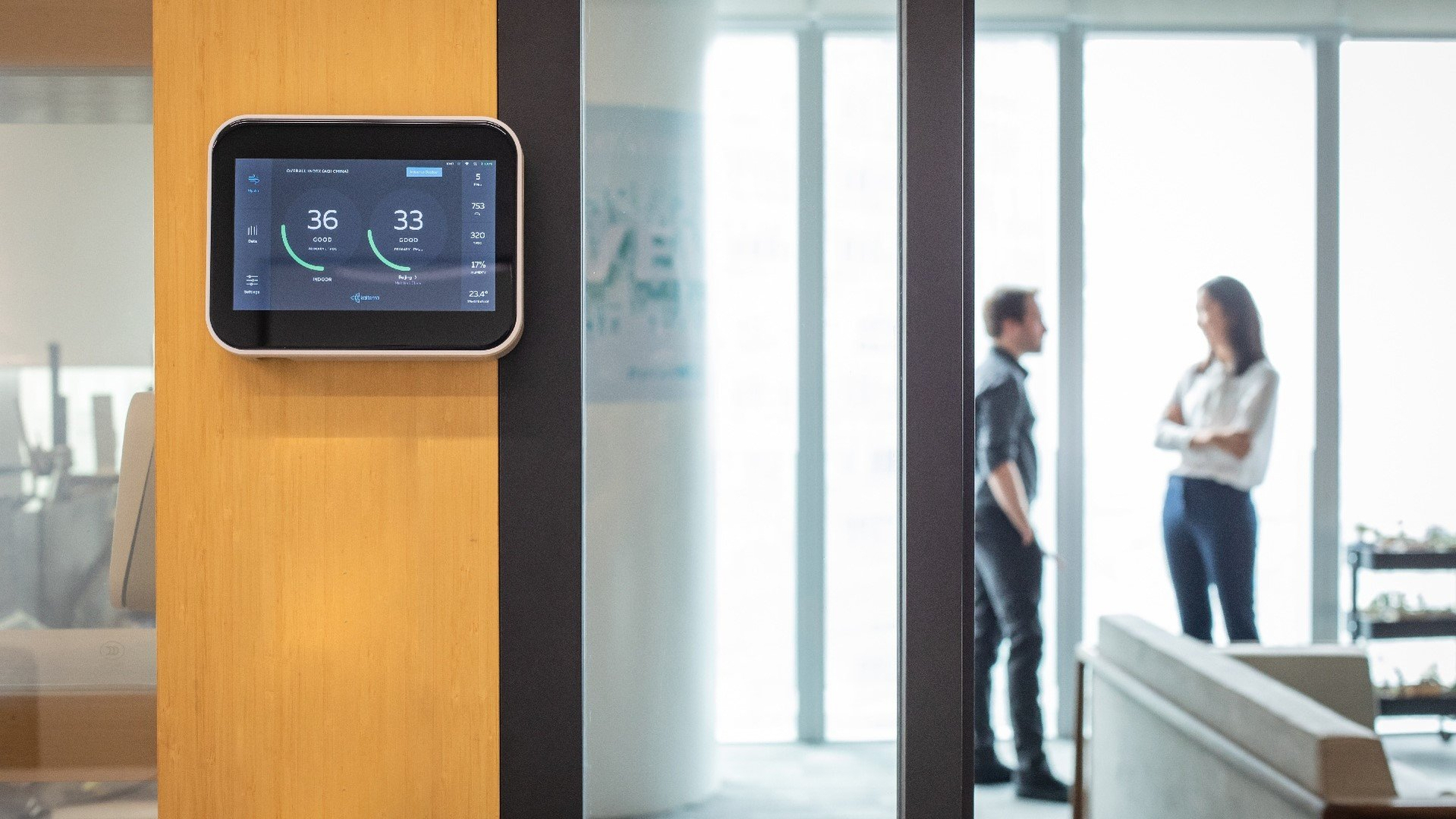Newsletter
Indoor air quality is one of the most important concepts in WELL Building Standards, and in this blog post, we will cover the requirements on air quality in WELL certification and WELL Performance Rating, and explain how you can meet these requirements and maximize your optimization points using continuous air quality monitors.
What Is WELL?
The WELL Standard was established by the International WELL Building Institute (IWBI) to advance health and wellness through the transformation of the built environment. Building off WELL v1, IWBI launched the WELL v2 program and the WELL Performance Rating, both of which focus almost exclusively on building occupant health and well-being.
While WELL v1 contained seven key concepts that applicants had to optimize for certification, WELL v2 has ten. These include physical conditions, like “Air”, “Light”, and “Water”, and more subjective areas, such as “Mind”, “Community”, and “Nourishment”. Because of the enormous impact of air quality on our bodies, air is listed first among the key concepts WELL aims to enhance. In the context of WELL as a certification program, improving air quality and air quality awareness can earn many points toward certification.

Image via https://www.wellcertified.com/
Air Quality Requirements in WELL Certification
Throughout its standards, WELL promotes excellent indoor air quality by rewarding diverse methods of improving and understanding air. The Air Concept in WELL Standards includes a total of 14 features, with four preconditions. These include eliminating and reducing sources of pollutants, intervening in behaviors that worsen air quality, and a special emphasis on monitoring or testing air quality to ensure an optimal indoor environment. We will explore the exact requirements in the next section.
When it comes to measuring and monitoring indoor air quality, there are two main pathways WELL accepts: sensor data and performance testing. We've done a deep dive on sensor data and performance testing pathway comparisons, outlining pros and cons for each approach. So below, we will focus on the sensor data pathway, aka, how you can meet WELL's requirements on Air and Thermal Comfort Concepts using air quality monitors.
How to Achieve WELL v2 With Air Quality Monitoring
Indoor air quality monitoring devices can help you secure the preconditions A01, A03, and T01, as well as earn your project points through A05, A06, A08, T06, and T07. Several of these features contain multiple parts, providing you with various options to meet the requirements. This article highlights the features, parts, and options that can be met by installing air quality monitors and meeting air quality thresholds via the sensor data pathway. We’ve broken down these categories below.
A01 Air Quality (Precondition)
The first feature listed under the Air concept is A01 Air Quality, which provides air quality thresholds to be verified through performance testing or sensor data, a letter of assurance from an engineer, or a shareable technical document. A01 has five parts, which detail air quality thresholds for different air pollutant types and how to verify that levels within a project do not exceed these limits.
- Part 1: PM2.5 levels are 15 μg/m³ or lower, and PM10 levels are 50 μg/m³ or lower, to be verified through a performance test or sensor data. Alternative thresholds are available for projects in highly polluted areas.
- Part 2: Formaldehyde levels are 10 µg/m³ or lower, Benzene levels are 50 µg/m³ or lower, and Toluene levels are 300 µg/m³ or lower in all occupiable spaces confirmed via laboratory testing. Alternatively, TVOC thresholds of 500 µg/m³ or lower are met in occupiable spaces that utilize continuous TVOC monitoring.
- Part 3: Carbon monoxide levels are 10 mg/m³ [9 ppm] or lower, and ozone levels are 100 µg/m³ [51 ppb] or lower, to be verified through a performance test or continuous monitoring.
- Part 4: Radon levels are 0.15 Bq/L [4 pCi/L] or lower, with a test being conducted for every 2,300 m2 [25,000 ft2] of regularly occupied space at or below grade. Alternatively, these regularly occupied spaces at or below grade meet Feature A03, Part 1, Option 1.
- Part 5: The pollutants listed in Parts 1-3 are measured annually and submitted through the WELL Digital Platform. Continuous monitors follow the requirements found in the Performance Verification Guidebook.
A03 Ventilation Design (Precondition)
In order to dilute natural and product-generated air pollutants, the A03 feature requires projects to bring fresh air into your spaces through natural or mechanical means to ensure adequate ventilation. There are four options for projects to choose from to meet this precondition:
- Option 1: Guidelines for mechanically ventilated spaces. Verified by Letter of Assurance - Engineer.
- Option 2: Guidelines for naturally ventilated spaces. Verified by Letter of Assurance - Engineer or Technical Document (Shareable).
- Option 3: Guidelines for naturally ventilated spaces in areas with elevated particulate matter. Verified by Letter of Assurance - Engineer or Technical Document (Shareable).
- Option 4: Guidelines for monitoring ventilation. Verified by Sensor Data.
Of these options, Option 4 can be met by continuous monitoring and verified by sensor data. Option 4 requires all occupiable spaces to be monitored for CO2 levels and ensure that they are either:
- 900ppm or less
- No higher than 500ppm compared to outdoor levels
A05 Enhanced Air Quality (4 Points)
Split into three parts, this air feature requires projects to go above and beyond current IAQ guidelines to provide enhanced air quality for the health and well-being of building occupants.
Part I: Meet enhanced thresholds for particulate matter is worth 2 points and is verified by either sensor data or a performance test. For all spaces, the threshold requirements are:
1 point:- PM2.5 ≤ 12 μg/m³
- PM10 ≤ 30 μg/m³
2 points:
- PM2.5 ≤ 10 μg/m³
- PM10 ≤ 20 μg/m³
Part 2: Meet enhanced thresholds for organic gases is worth 1 point, verified by performance testing.
-
Acetaldehyde: 140 µg/m³ or lower
-
Benzene: 3 µg/m³ or lower
-
Formaldehyde: 9 µg/m³ or lower
-
Naphthalene: 9 µg/m³ or lower
-
Toluene: 300 µg/m³ or lower
-
One of the following:
-
Acrylonitrile: 5 µg/m³ or lower
-
Caprolactam: 2.2 µg/m³ or lower
-
Part 3: Meet enhanced thresholds for inorganic gases is also worth 1 more point, verified by sensor data or performance testing.
For all spaces, the following thresholds must be met:
- Carbon monoxide less than 7 mg/m³ [6 ppm]
- Nitrogen dioxide less than 40 µg/m³ [21 ppb]
A06 Enhanced Ventilation Design (2 Points)
Building off of A03, this feature calls for advanced natural or mechanical ventilation methods in order to secure a maximum 2 points through continuous monitoring.
Part 1: Increase outdoor air supply is worth 2 points.
There are four options to meet this requirement:
- Option 1: Increased air supply. Verified by Letter of Assurance - Engineer.
- Option 2: Demand control ventilation. Verified by Letter of Assurance - Engineer.
- Option 3: Enhanced natural ventilation. Verified by Technical Document (Audited).
- Option 4: Ventilation monitoring. Verified by Sensor Data
Implementing IAQ monitoring allows you to go through Option 4: Ventilation monitoring to meet the requirement of Part 1 and gain 2 points.
Under Option 4, one of the following carbon dioxide thresholds is met in occupiable spaces:
- 750 ppm or less.
- Not more than 350 ppm above outdoor levels.
A08 Air Quality Monitoring and Awareness (2 Points)
WELL divides air quality monitoring and awareness optimization into two distinct parts. Part 1 focuses on implementing air quality monitors, and Part 2 focuses on promoting air quality awareness.
Part 1: Implementing air quality monitors is worth one point and sets air quality parameters, density, data, and calibration requirements for air quality monitors used for WELL. To satisfy these criteria, monitors must measure three of the following, in compliance with the requirements outlined in the Continuous Monitoring Protocols of the Performance Verification Guidebook:
- PM2.5 or PM10 (accuracy 25% at 50 μg/m³)
- Carbon dioxide (accuracy 10% at 750 ppm)
- Carbon monoxide (accuracy 1 ppm at values between 0 and 10 ppm)
- Ozone (accuracy 10 ppb at values between 0 and 100 ppb)
- Nitrogen dioxide (accuracy 20 ppb at values between 0 and 100 ppb)
- Total VOCs (accuracy 25% at 500 μg/m³)
- Formaldehyde (accuracy 20 ppb at values between 0 and 100 ppb)
Alternatively, sensors that are RESET accredited Grade B or above may be utilized, so long as they meet the calibration, measurement interval, and reporting frequencies outlined below:
Calibration:
- Sensors are recalibrated or replaced every 3 years, and projects submit documentation attesting to their calibration or replacement every three years through the WELL digital platform.
- Sensors measuring thermal comfort parameters are recalibrated or replaced every three years, and projects submit documentation attesting to their calibration or replacement every three years through the WELL digital platform.
Measurement intervals:
- Sensors must provide continuous measurements during occupied hours.
- Measurements are taken at intervals of no longer than 1 hour for radon, and 15 minutes for other parameters.
Reporting Frequency:
- Data are submitted annually through the WELL digital platform.
The placement and density of the monitors also must fit the following criteria:
-
Monitor density is tiered based on a project's occupiable space:
-
Projects with occupiable space of < 3250 m2: 1 monitor per 325 m2 [3,500 ft2] in occupiable spaces (minimum 2)
-
Projects with occupiable space of 3250-25,000 m2: 1 monitor per 500
m2 [5,400 ft2] in occupiable spaces (minimum 10)
-
Projects with occupiable space of > 25,000 m2: 1 monitor per 1000 m2 [10,800 ft2] in occupiable spaces (minimum 50)
-
-
Monitors are located 3.6-5.6 ft above the finished floor at locations where occupants would typically be seated or standing and at least 3.3 ft away from doors, operable windows and air supply/exhaust outlets.
Part 2: Promote Air Quality Awareness takes Part 1 a step further. To encourage the dispersion of air quality data to regular building occupants, WELL offers an additional point for projects to display their air quality data either through display screens or through digital means, including a phone application or website.
T01 Thermal Performance (Precondition)
Comfortable thermal conditions are required here in order to meet this precondition. Projects must ensure regularly occupied spaces are thermally maintained at levels outlined in the WELL guidebook.
Continuous monitoring can help you achieve both Parts 1 and 2 of this precondition by measuring and maintaining dry-bulb temperatures between a specified range based on your project’s ventilation method, and by meeting Feature T06 requirements which are covered in the section below.
T06 Thermal Air Comfort Monitoring (1 Point)
To attain points for T06, projects must monitor thermal parameters (dry-bulb temperature and relative humidity) in real-time and display environmental measures according to specific guidelines. The following monitor requirements must be satisfied for your building project to gain points for thermal comfort monitoring:
- The project monitors temperature and relative humidity with sensors that comply with the Device Requirements listed in the WELL Performance Verification Guidebook.
- Real-time data displaying temperature and humidity are made available in all regularly occupied spaces. There must be a minimum of one display screen, or signage on how to access a website or mobile application per every 5,400 ft2 of occupiable floor area.
- Data are submitted annually through the WELL digital platform.
-
Sensors are recalibrated or replaced at least every three years and certificates attesting to their calibration or replacement are submitted every three years through the WELL digital platform.
Like Part 2 from A08, projects need to go beyond parameter monitoring and provide thermal comfort values to regular building occupants. Again, these readings can be provided by a display or through digital options, including a phone application or website.
T07 Humidity Control (1 Point)
Feature T07 is achieved by controlling relative humidity for at least 98% of operating hours during the year. The systems required to achieve this goal will vary based on physical location and will be affected by the arrangement of building entrances and locations used for taking humidity measurements.
Projects that meet feature T06: Thermal Air Comfort Monitoring, and maintain humidity between 30% and 60% in regularly occupied areas can satisfy requirements for Option 3 via continuous monitoring.
The WELL Performance Rating
For those looking for a more flexible approach, the WELL Performance Rating provides an alternative to, or stepping stone towards, WELL v2. This new standard is focused on data-driven forms of monitoring and allows you to select a subset of goals from WELL v2 that most suits your business needs. Unlike v2, there are no tiers or preconditions required. Of a total of 33 features, spread out across seven themes, you must select 21. The themes included are:
- Indoor Air Quality (9 features)
- Water Quality Management (4 features)
- Lighting Measurement (2 features)
- Thermal Conditions (2 features)
- Acoustic Performance (5 features)
- Environmental Monitoring (6 features)
- Occupant Experience (5 features)
Verification Pathways for the WELL Performance Rating:
The Well Performance Rating also offers new ways to verify the improvements and optimizations that the standard requires you to make. It’s possible to get accredited using just one of these methods, but most companies rely on a combination. These pathways to verification take place in the following three ways:
- On-site inspection conducted by a WELL Performance Testing Agent.
- Continuous monitoring, usually via air quality monitors. The data is then sent to WELL for analysis.
- Occupant surveys that provide data or either Occupant Experience or Thermal Comfort.
The WELL Performance Rating: Accreditation And Renewal
The first step to achieving WELL Performance Rating accreditation is choosing 21 of the 33 features that are more important to you. Once this is done, you can begin to implement the strategies needed to achieve these features, such as air quality monitor installation and occupant surveys.
You must provide one month’s worth of data from your selected features in order to get accredited with the WELL Performance Rating. As mentioned, these can be taken from customer surveys, continuous monitoring, or on-site inspection. Renewal takes place annually and requires data that covers the previous year.
The WELL Performance Rating: How Air Quality Monitors Can Help
Like WELL v2, the WELL Performance Rating acknowledges the considerable impact that air quality can have on occupant health. Reflecting this, “Indoor Air Quality” contains nine features, significantly more than any other theme. Not only can IAQ monitoring help you secure most of the features in the Indoor Air Quality category, it can also cover some of those in “Thermal Conditions” and “Environmental Monitoring”, potentially earning you 13 of the necessary 21 points. You can see how this might work below:
Indoor Air Quality (+ 7 points)
- PA1 Meet Thresholds for Particulate Matter
- PA2 Meet Enhanced Thresholds for Particulate Matter
- PA3 Meet Thresholds for Organic Gasses
- PA4 Meet Enhanced Thresholds for Organic Gases
- PA5 Meet Thresholds for Inorganic Gasses
- PA7 Ensure Adequate Ventilation
- PA8 Increase Outdoor Air Supply
Thermal Conditions (+ 2 points)
- PT1 Provide Acceptable Thermal Environment
- PT2 Manage Relative Humidity
Environmental Monitoring (+ 4 points )
- PM1 Measure Air Parameters
- PM2 Install Indoor Air Monitors
- PM3 Promote Air Quality Awareness
- PM4 Monitor Thermal Environment
Earning Points Toward WELL with Air Quality Monitors From Kaiterra
While performance testing used to be the only way to meet the requirements for A01 in WELL v2, new monitors like the Kaiterra Sensedge Go make it possible to satisfy all air quality testing-related preconditions (A01 and A03) as well as precondition T01 and earn up to nine optimization points (in features A05, A06, A08, T06, T07) with continuous monitoring alone — no performance testing needed. The same device can add up to 13 of the 21 features required for the WELL Performance Rating.
The table below contains a breakdown of how the parameters that the Sensedge Go measures can contribute to your WELL v2 score. (Note: simply monitoring the parameters doesn't guarantee the points under each feature or part.)
| Parameter | WELL v2 Feature/Part | |
| Particulate Matter 2.5 | PM2.5 | A01 Part 1; A01 Part 5; A05 Part 1; A07 Part 2; A08 Part 1 |
| Particulate Matter 10 | PM10 | A01 Part 1; A01 Part 5; A05 Part 1; A07 Part 2; A08 Part 1 |
| Total Volatile Organic Compounds | TVOC | A01 Part 2; A01 Part 5; A08 Part 1 |
| Carbon Monoxide | CO | A01 Part 3; A01 Part 5; A05 Part 3 |
| Carbon Dioxide | CO2 | A03 Part 1; A06 Part 1; A08 Part 1 |
| Nitrogen Dioxide | NO2 | A05 Part 3 |
| Ozone | O3 | A01 Part 3; A01 Part 5; A08 Part 1 |
| Temperature (dry-bulb) | Tdb | A07 Part 2; T01 Part 1; T01 Part 2; T06 Part 1; T07 Part 1 |
| Relative Humidity | RH | A07 Part 2; T01 Part 1; T01 Part 2; T06 Part 1; T07 Part 1 |
Learn more about how Kaiterra can support your journey to WELL certification..
Why Choose Kaiterra for Your WELL Project
From installation to continuous training, automated smart reporting, and support on improving your indoor environment, Kaiterra’s air quality monitoring solutions are designed to help you achieve WELL v2 certification and WELL Performance Rating, adding value at every step:
Replace Performance Testing
By eliminating the need for performance testing for air, the Sensedge Go makes it possible to achieve WELL v2 certification at a lower cost and with significantly less work. On average, WELL projects need at least two performance tests per building, and each test costs approximately $10,000 (the costs multiply exponentially if your project is certifying a portfolio of several buildings).
Moreover, coordinating the logistics for several performance tests — including scheduling tests months in advance and ensuring your building has the right conditions to pass at the time of testing — can be incredibly tedious and time-consuming, especially if you have a global portfolio.
By installing continuous monitors, WELL projects can drastically reduce the time and costs required to verify their air quality. The Sensedge Go air quality monitor is both wireless and battery-powered, making installation and set-up efficient and hassle-free (you can set up a building of monitors in a matter of minutes), offering a more time-efficient alternative to performance testing.
After installation is complete, the long-term costs are minimal. Altogether, Kaiterra’s air quality monitors can help you meet WELL’s requirements for significantly lower costs than performance testing.
Earn Nine Optimization Points
Compared to other air quality monitors WELL projects can use for certification, the Sensedge Go monitors a more comprehensive list of air quality parameters, providing the opportunity to score up to nine points in the Air and Thermal Comfort optimization features (in addition to satisfying three preconditions).
This is the highest return on WELL points offered by any air quality monitoring solution on the market — these nine points can easily take your project to the next level of certification with almost no extra work.
Easy Calibration, Lowest Maintenance Cost
With an innovative modular design, Kaiterra IAQ monitors — the Sensedge, Sensedge Mini, and Sensedge Go — can be easily recalibrated by swapping out old sensors for new ones. New sensors come with a certificate of calibration, which you can submit to WELL online. This process replaces traditional and field calibration methods, which significantly reduces your maintenance costs and sensor downtime.
Advanced Data Analytics and Reporting
The Kaiterra Dashboard provides a new way of analyzing your IAQ data, delivering far more value beyond achieving WELL certification. You can manage, compare, and analyze your data in one place and generate intelligent reports with our pre-built template. Users can opt-in to receive weekly reports with detailed insights, optimization tips, and opportunities to improve IAQ — all powered by Kaiterra’s unique algorithm.
You can also leverage the WELL Compliance Report to get a clear pass/fail result, helping you stay on top of your certification progress, and export your data directly in the format recognized for WELL certification.
Proven Success: Kaiterra Commercial Air Quality Monitoring in IWBI’s NYC Office
In 2019, IWBI’s global headquarters relocated its office and earned a WELL Platinum rating.

IWBI utilized the Kaiterra Sensedge in its NYC headquarters.
Featuring Kaiterra’s Sensedge, among other indoor health optimizations, IWBI received over 80 points toward its own certification program. To read more about this project, check out our full case study: How IWBI Transformed Its Aging NYC Office Into a Healthy Workplace.
For more inspiration, take a look at how some leaders in business and commercial real estate achieved WELL Platinum status (Often with a little help from Kaiterra IAQ monitoring solutions!) here.
Kaiterra’s commercial air quality monitoring devices are great options for not only WELL, but also RESET, LEED, and more. Find out more about our commercial line of air quality monitors by reaching out to our team below!






.png?width=200&height=148&name=Menu%20C%20(2).png)

.png?width=307&height=228&name=Menu%20-%20D%20(1).png)
.png)





